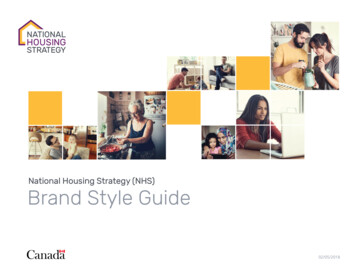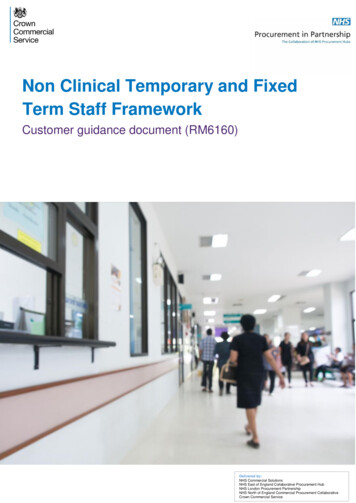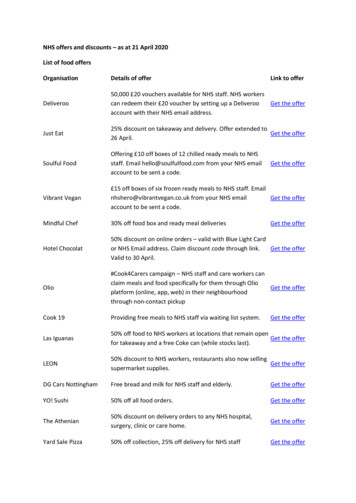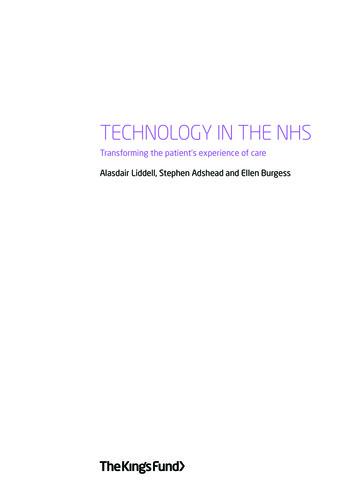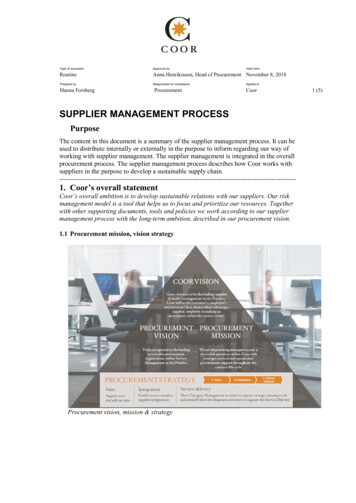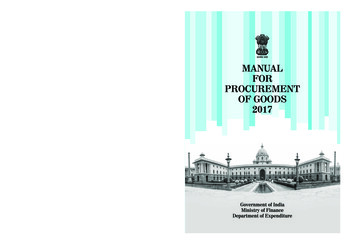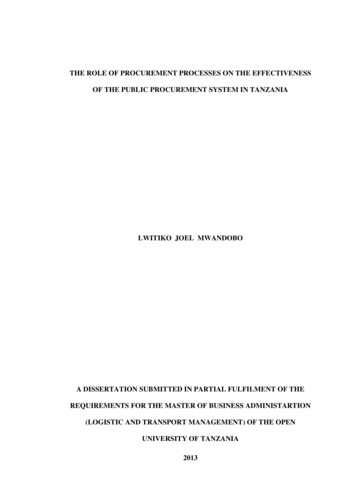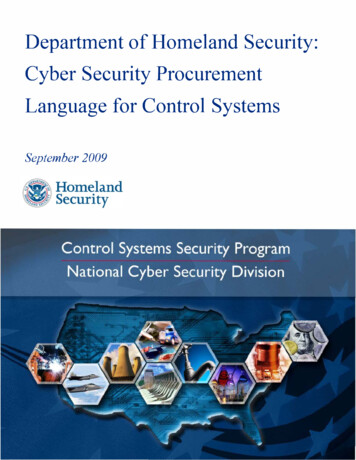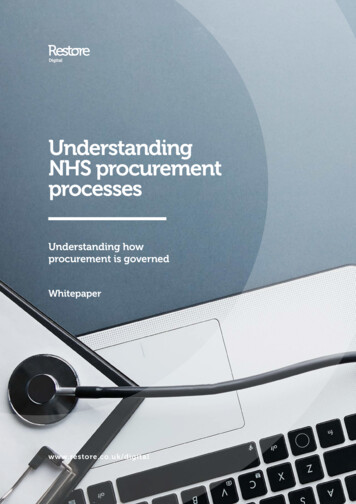
Transcription
UnderstandingNHS procurementprocessesUnderstanding howprocurement is governedWhitepaperwww.restore.co.uk/digital
Restore are privileged to support 81% of NHS Trustswith various document management solutions. Thishas created vast experience across the group of the NHSprocurement process, and how a Trust can successfullytender for a large digitisation project.Money is available, whether through the Digital Exemplarprogramme, as a Fast Follower or the NHS Digital Fundingscheme. However, that budget is still limited and beingconfident on ROI is essential.Commencing a procurement process needs to guaranteeyou receive the information you need to make the rightdecision. Plus, it elicits accurate and realistic pricing.This whitepaper is designed to provide simple advice whenapproaching digital transformation procurement in the NHS.#RestoreAnswers0333 043 5496info@restoredigital.co.uk
Understandinghow procurementis governedProcurement within NHS Trusts is governed by a setof UK and EU principles. These seek to ensure a ‘levelplaying field’ for procurement teams and suppliers. Theprinciples are legally binding within certain thresholds.Many NHS Trusts apply them throughout theirprocurement strategy. These principles are:EU principles of procurementTransparencyProcurement activity shall be advertised appropriatelyto ensure market visibility and provide clearinformation on the process, contractual requirements,performance and the method(s) of evaluation beingused in the determination of a successful bid.ProportionalityThe approach taken in any given procurement activitywill be proportionate to the level of complexity,impact, risk and value of the activity as to not preventor discourage bidders.1
EqualityEnsuring that all providers and sectors have equalopportunity to compete where appropriate, thatfinancial and due diligence checks apply equally andare proportionate, and that pricing and paymentregimes are transparent and fair.Non-discriminatoryThe consistent application of the Regulations and Trustrules to all procurement activity to ensure than nomember state supplier is prevented from participatingin an EU tender on the grounds of nationality, orsubject matter of the contract.Mutual recognitionMember states will recognise equivalent measures ofqualifications, standards etc.2
UK principles of procurementFavour competitionProcurement activity should be undertaken in acompetitive environment to aid in demonstrating theEU and UK principles as well as VFM.RobustProcurement activity should be legally robust toensure compliance and account of decisions madeand/or actions taken. The specification of the servicesand the terms and conditions shall ensure the Trustand its patients are safeguarded appropriately.AccountabilityAll procurement activity will have an accountableoffice of the Trust to sign off on the compliance of theprocurement process(es) used.Value for moneyAll procurement activity will seek and demonstrate thebalance between quality and cost reflecting in a valuefor-money (VFM) decision.QualityProcurement activity will set out the minimum qualityof goods, works or services/outcomes to be achievedby though the specification of the contract.3
FraudpreventionAccording to the latest estimate by the NHSCounter Fraud Authority, fraud costs the NHS 1.29 billion a year.This covers a whole range of economic crimes, somebut not all relating to the tender process.Those committing fraud are a minority, but theirconsequences are huge.4
Types of fraud can include:False ClaimsPayment diversionPatients claiming freetreatment they are notentitled too. Or, NHSprofessionals claimingmoney for servicesthey’ve not provided.Fraudsters trick an NHSorganisation to paymoney to them. Forexample, pretending tobe one of your regularsuppliers.Procurement fraudTimesheet fraudBid rigging. Whenbidders agree betweenthemselves to endcompetition. Denyingthe organisation a fairprice or delivery ofpoor-quality goods orservices.Staff falsifyingtimesheets.5
There must be a separation of duties within the Trustto protect against fraud and errors. This is usuallyachieved by dividing the process between two ormore people. So that no one person handles the entirepurchasing process.The three areas of authority to divide are:The person with authority over the budgetAuthority to seek quotations/tenders,negotiate and commitAuthority to accept an invoice and pay.You support this by creating a tender process withcontrol points throughout. Often used controlledpoints by NHS Trusts include:Specification/requisition processDuly authorised representative to approve thespecification or raise a requisition.Selection processTerms of Reference of evaluation panels, the use ofconsensus and moderating scoring.6
Contract awardScheme of reservation to SFI’s three mandates who orwhich Board are duly authorised to approve/ratify therecommendation to award a contract.Goods receivedThe requisitioner is responsible for ensuring goods,services and/or works received match those orders inall aspects.Services performedThe named Contract Manager is responsible forensuring the performance of the services to thespecified/agreed standards.Payment processMatching goods received notices with purchase ordersand invoices – processing via Trusts’ Procurement-2Pay process.7
The procurementprocessThe process is governed by the UK Public ContractRegulations of 2015 and there are different ways toapproach a procurement process.Conditions relating to the GPA and otherinternational agreements (PRC Regulation 25)In so far as they are covered by Annexes 1, 2 and 4 to7 and the General Notes to the EU’s Appendix 1 to theGPA and by the other international agreements bywhich the EU is bound, contracting authorities shallaccord to the works, supplies, services and economicoperators of the signatories to those agreementstreatment no less favourable than the treatmentaccorded to the works, supplies, services andeconomic operators of the EU.Open procurement (PRC Regulation 27)Where a notice is placed in the Official Journal invitingtenders from those that meet declared minimumcapacity levels, all of those who submit their tender bythe data specified in the notice must be considered.8
Restricted procurement (PRC Regulation 28)When a contract notice is placed in the Official Journalof the European Union (OJEU) inviting expressions ofinterest along with proof of capacity. Only suppliersthat meet the minimum requirements and areshortlisted using the rules for further selection will beinvited to the tender.Competitive with negotiation (PRC Regulation 29)Where a notice is placed in the OJEU and from thosewho respond participants are chosen following thesame process as the restricted procedure, above.Competitive with Negotiation allows greater flexibilitywhen the needs of the contract cannot be met withoutadapting readily available solutions, where it involvesdesign or innovative solutions, where the subjectrequires complex negotiations or where a specificationcannot be defined with adequate precision.This procedure is only available where a Trust islooking to award a particularly complex contract (asdefined in the relevant Regulation) and where theTrust feels the open and restricted procedures will notallow the award of that contract.9
Competitive dialogue (PRC Regulation 30)Where a notice is placed in the OJEU and from thosewho respond participants are chosen following thesame process as the restricted procedure, above. Adialogue is then begun with the selected participantswith the aim of establishing how the Trust’s needs canbe best satisfied.Throughout the process, the Trust must take careto ensure the principles of equal treatment andtransparency are adhered to and that a genuinecompetition has taken place.This procedure is only available where the Trust islooking to award a particularly complex contract (asdefined in the relevant Regulation) and where theTrust feels the open and restricted procedures will notallow the award of that contract.Innovation partnership (PRC regulation 31)Innovation partnerships are a new concept in EUprocurement law. They are intended to be long termpartnerships which allow for both the developmentand subsequent purchase of new and innovativeproducts, services or works.The term “partnerships” is not used in a technicalsense to mean legal partnerships as defined under UKlaw. The term is used to indicate the partnering typeapproach to working together.The process is similar to the restricted procedure.Advice must be taken prior to selecting this process.10
Negotiated procedure (PRC Regulation 32)Where a contract notice is placed in the OJEUinviting expressions of interest along with proof ofcapacity. Only suppliers that meet the minimumcapacity requirements, and are shortlisted usingthe rules for further selection, will be invited tonegotiate the contract (usually using a tenderinground). This procedure is only available in very limitedcircumstances (principally relating to uncertainty ofthe requirement) which are like those permitting theuse of the competitive dialogue procedure. In certainvery limited instances, the negotiated procedure isavailable without publishing a call for competition.Trusts who use these procedures must be able, ifchallenged, to justify their decision and show that thegrounds set out in the regulations have been met. It isimportant that there is an audit trail including, whererelevant, why the open and restricted procedures werenot considered appropriate.Accelerated procedureThe accelerated procedure is to be used exceptionally,and the Trust must indicate its reasons in the notice tothe Official Journal. Generally, the reasons for urgencyshould be external, i.e. not resulting from delay by thepurchaser. Also, it is important to regard the 10/15-dayperiods as minimum periods: the contracting authorityshould allow the maximum time practicable.11
Frameworks and mini competitionsWhere existing, EU compliant contractual Frameworkexists which the Trust can access, the requirements setout in the Framework will be adhered to in undertakingany further competition. Options available under aFramework are typically, a) Direct Award, undertakenwithout further competition of the business or b)a mini-competition amongst the suppliers on theFramework / Lot of the Framework. Where minicompetitions are undertaken, the Trust shall fulfil therequirements of the Framework and ensure all other,over-arching compliance requirement are met.Dynamic purchasing systemsWhere an EU compliant Dynamic Purchasing System(DPS) is available for the Trust to use, the requirementsas set out in the DPS will be adhered to. Where furthercompetition is undertaken (i.e. a mini competition),the Trust shall fulfil the requirements of the DPS andensure all other, over-arching compliance requirementare met.Electronic auctionsWhere a reverse auction style platform is establishedwith bidders able to place bids of reducing amounts inorder to secure the opportunity. These events requirespecialist input from the Procurement Department andthird-party auction provider.12
Formal quotesWhere the value of the purchase including VAT isbetween 25k and 50k, formal quotes must besought in accordance with the requirements of theGovernment Contracts Finder.Quick quotesWhere the value of the purchase including VAT isbetween 10k and 25k where the Trust must complywith the SFi’s and the requirement to demonstrateValue for Money.Prior Information Notices (PIN)A Prior Information Notice (PIN) when used inaccordance with the UK Public Contract Regulations2015 can be used to reduce the timescales applicableto tenders above the EU threshold. In such instances,the PIN must be published at least 35 calendar daysprior to the publication of the Contract Notice but notgreater than 365 calendar days.13
Invitation for bids/proposalsPrior Information Notices (PIN)A Prior Information Notice (PIN) can be used toprepare the market for upcoming opportunities withinthe next 12 months. Publishing a PIN in the OfficialJournal of the European Union (OJEU) allows for somereductions in the minimum timescales required duringcertain procurement processes. For a PIN to be valid,it must be issued at least 35 calendar days prior to thecontract notice and be less than 12 months old.Contract Notices (call to competition)The Contract Notice acts as a call for competitionfor a specific contract and should be published viathe Official Journal of the European Union (OJEU)as soon as possible after the intention to tender hasbeen formed. It provides specific details of the contractas well as criteria for applicants to be selected forinvitation to tender in the restricted and competitiveprocedures. Publication is mandatory other than forcontracts covered under the Light Touch regime(Regulation 74 of PCR 2015).14
Letter of InvitationA covering letter must be included in all Invitation toTender (ITT) opportunities. The Letter should provide asummary of the key points regarding the opportunityand the contact details for the lead procurementofficer. Procurement has a standard template availableupon request.Instructions to BiddersThe ITT documents must include a clear and explicitset of instructions to all bids regarding how to bid, howbids will be assessed and details of any mandatoryrequirements / exclusive criteria. Procurement has astandard template available upon request.15
Flow chartsdepicting some ofthe procurementprocess optionsWe’ve picked out a few of these procurementapproaches and created flow charts to help bring themto life.16
Open procedure within the public sectorPublish contract notice30 calendar daysminimum. Less 5 daysif tender documentsare available forimmediate download.15 calendar daysminimum where aPIN has been issuedNo prescribedtimescales butestimate 30 calendardays to complete10 calendar daysminimumReceive Expressions ofInterest (EoI)Issue tender documentsto each EoIDeadline for reciept oftender submissionInclude publication toContract Finder if theanticipated lifetimevalue of the contractwill exceed 25k6 Calendar daysmaximum to respondper EoI request if thedocuments are notavailable electronicallyand for download.Evaluate tendersubmissionand determine thewinning bidGain approval ofrecommendationand awardMandatorystandstill periodNo prescribedtimescales butestimate 60 calendardays to completeAward & sign contractPublish the awarddecision/s onContracts Finderwithin reasonabletimescalesPublish contractaward notice30 Calendar daysmaximumRaise requisition17
Restricted procedure within the publicsector30 calendar daysminimum. Less 5 daysif tender documentsare available forimmediate download.15 calendar daysminimum where a PINhas been issued30 calendar daysminimum. Less 5 daysif tender documentsare available forimmediate downloadand/or less 15 dayswith the publication ofa PIN. Minimumtimescales withelectronic discounts is10 days.No prescribedtimescales but estimate30 calendar days tocomplete.10 calendar daysminimum.Publish contract noticeInclude publication toContracts Finder if theanticipated lifetimevalue of the contractwill exceed 25k.Evaluate PQQ againstselection criteriaNotify un/successfulbiddersIssue tender documentsDeadline for receipt oftender submissionEvaluate tender againstaward criteria todetermine the winning bidGain approval ofrecommendation andawardMandatory StandstillperiodNo prescribedtimescales but estimate60 calendar days tocomplete.Award and sign contractPublish the awarddecision/s on ContractsFinder withinreasonable timescales.18Publish contractaward noticeRaise requisition30 calendar daysmaximum.
Frameworks - Mini CompetitionsApply FrameworkinstructionsThe minimum calendardays will be detailed inthe Frameworkguidance. Theinstructions may varyfrom Framework toFramework and evenbetween the Lots of aFramework.Identify the Lot requiredIndentify the supplier onthe LotYesValue 25K?Publish onContracts FinderNoIssue tender documentsDeadline for receipt oftender submissionNo prescribedtimescales but estimate10 calendar days tocomplete.Evaluate tenderagainst award criteriato determine thewinning bidGain approval ofrecommendationand awardOptional standstill period10 calendardays minimum.Publish the awarddecision/s on ContractsFinder withinreasonable timescales.No prescribedtimescales but estimate20 calendar days tocomplete.Award and signcontractRaise requisition19
Direct award under a FrameworkEnsure that a DirectAward is an optionunder the Framework.Guidance will beprovided by theFramework operator.Gain approval ofrecommendationand awardOptional standstill period10 calendardays minimum.Publish the awarddecision/s on ContractsFinder withinreasonable timescales.20Award and signcontractRaise requisitionNo prescribedtimescales but estimate60 calendar days tocomplete.
EU Tender - Choice of procedureQuestion 1YesNoQuestion 2YesNoQuestion 3NoOpen procedure (PCR 27)YesQuestion 4YesRestricted procedure (PCR 28)NoQuestion 5NoYesCompetitive dialogue (PCR30) or competitive withnegociation (PCR 29)Q1. Can you evidence that there is only one suppliercapable of meeting the requirements?Q2. Is the requirement extremely urgent andgenuinely unforeseeable?Q3. Do you need to “pre-qualify” suppliers?Q4. Can you completely define the requirement now?Q5. Are you in one of the situations listed in PCR 25?21
Choosing the righttender FrameworkOnce you know what type of procurement process,you need to find the right tender framework. SomeNHS Trusts have already made the decision. Whereassome allow the decision to be made by each project’sprocurement team.A summary of some of the frameworks are below.However if you have flexibility, we recommend youmeet with each, interview them and find the rightportal for your project.Our NHS consultant can run you through the portalsand your options in more detail. Why not pop us anemail if you have any questions:info@restoredigital.co.uk22
NHS Supply ChainThe framework now covers digital solutions for: imagemanagement, departmental information systems,clinical information systems, vendor neutral archiving,document management, specialist apps, e-prescribingand genomics.Crown Commercial Service (CCS)The CCS is an executive agency, sponsored by theCabinet office. It brings together policy, advice anddirect buying, providing commercial services to thepublic sector and saving money for the taxpayer.Health Trust EuropeFor NHS and private healthcare organisations, HTEprovide an integrated contracting process to ensurethe highest quality products are obtained at the bestprice for its members.NHS Shared Business ServicesOur extensive portfolio of framework agreementsis designed to ensure ease of access and offer acompliant route to market for NHS and public sectororganisations. The NHS Shared Business Services (NHSSBS) framework contracts cover health and corporateservices including IT, Legal, Estates & Facilities andBusiness Services.23
NHS South of England Procurement ServicesPortsmouth Hospitals NHS Trust (“the Trust”) hasestablished this framework to provide a range of NHSback office services, including financial, procurement,employment and data warehousing services, for itselfand for the benefit of other public bodies. The Trustconsiders that the framework agreement will enablethe wider public sector to benefit from a streamlinedservices delivery approach.The NHS Collaborative Procurement PartnershipThe NHS CPP are a group of four NHS procurementhubs set up to develop supply chain collaborationin the NHS and cut duplication by identifyingprocurement opportunities for each hub and sharingthe information.Together they represent about 60% of NHS trusts andcontrol between 6bn to 7.5bn of non-pay spends.The four hubs, NHS Commercial Solutions (CS), East ofEngland NHS Collaborative Procurement Hub (EOE),NHS North of England Commercial ProcurementCollaborative (NOE CPC) and NHS LondonProcurement Partnership (LPP) support more than 160NHS organisations as members.ESPOWith many years of working experience in the fieldsof social care, NHS and in public procurement, thiscategory offers the expertise needed to establishframeworks across the whole of the social care andhealth sector.24
Essential questionsNHS Trusts shouldask in archivescanning tendersA clear list of any standards or certificationyou want, and whether you want evidenceby certification, or assurance they areadhered to.Reassurance on the organisation’s businesscontinuity and disaster recovery. Specifyall the parts of the process you want theanswer to cover, so you don’t get a vague,high level answer. For ost scanning, hosting of imagesDestruction25
Understand the collection process, thebooking in process, preparation andscanning. Are there specific requirementsyou want? DPI, colour, additional prep asthe documents are fragile?Understanding of the quality control andassurance process so you are confidentwhen and how this occurs.Understanding of the full audit trail. Howcan you be confident every file can belocated when if needed urgently?Security and confidentialityooooSite securityElectronic dataAccess to recordsFile storageAn overview of the destruction process,if needed, and how you can be confidentin the process. Think about providingdirection on areas such as:ooooo26Retention periodsWhether in-house or outsourcedGovernance arrangementsAudit processCertification
Understanding of the project managementprocess, and the proposed project planand timescales based on the informationyou provide in the ITT. How are you keptinformed on the project on a regular basis?Understanding of the options for returningthe electronic files post scanning. Do youhave a system it needs to be uploaded into?Or, do you want a variety of options?References: ask for three relevant casesstudies, plus reference details for you tospeak to these references. Ideally, otherNHS Trusts who have embarked on asimilar project.27
A draft pricingtemplate for anNHS archivescanning projectCreating a pricing schedule that works for yourproject can be difficult. If you know the scanning fixedquantity, then it can be a little easier. For example, Ihave X boxes of patient records stored in one site nearthe hospital. We want to clear this location in one go,and scan all files, as we want to sell or use the propertyfor something else.Others have a huge archive of patient records inmultiple locations. They may want to start a dayforward scanning project. Quantities are harder topredict. In this situation you may want to band thequantities to see where your equilibrium point may be.Below is an example template for archive or dayforward scanning.28
You may not need all field. You may well want to bandthe responses along the top into for example: up to 1,000 images; 1,000-2,000 images p.a., 2,000 – 3,000 images p.a. etc.Have a look, but feel free to pick up the phone. We cantalk you through the pricing template and help createone that works for your project.Scanning (per Image)Black & White (Single-sided, up to 200 DPI)Black & White (Duplex, up to 200 DPI)Colour (Single-sided, up to 200 DPI)Colour (Duplex, up to 200 DPI)X-rayMicrofilmBook% Increase for additional 100 DPIScan on Demand Black & White (Single-sided, up to 200 DPI)Scan on Demand Black & White (Duplex, up to 200 DPI)Scan on Demand Colour (Single-sided, up to 200 DPI)Scan on Demand Colour (Duplex, up to 200 DPI)Scan on Demand % Increase for additional 100 DPI29
Storage per month (for Scan on Demand items)File (based on 1.5 cu. ft. Box, 10 Files per Box)Digital Retrieval (per File, based on annual average)Urgent (2-hour)Next Working Day (before 9am)Next Working Day (before 12pm)Next Working Day (before 5pm)Retrieval (excl. Trip Charge, based on one location,may be multiple sites)Urgent Retrieval (4-hour)Next Working Day (before 9am)Next Working Day (before 12pm)Next Working Day (before 5pm)30
Recall (in case the item is required prior toscanning, based on annual average)Urgent (4-hour)Next Working Day (before 12pm)Next Working Day (before 5pm)Five Working DaysCollection/Delivery and Putaway (per File, per day,per site, based on annual average)Urgent (4-hour, excl. mileage)Next Working Day (before 9am, excl. mileage)Next Working Day (before 12pm, excl. mileage)Next Working Day (before 5pm, excl. mileage)Five Working Days (excl. mileage)31
Ask for helpHaving as much information as possible ahead of aformal procurement process is key. NHS Trusts andyour procurement teams should reach out to suppliers.They can help inform the tender process and ensureyou have all the information you need to write the ITT.Suppliers will be more than willing to meet with you.Meeting ahead of a tender process does not meansthose suppliers are in a better position that a supplierwho responds to an ITT that you haven’t met.See scanning centres in action. Understand theprocess. Ask questions about the delivery of yourproject. This will make it easier to understand who willdeliver the quality you are after.Let suppliers see the patient records you want to scan.Understand if your files are straight forward or whetherthey’ll need extra preparation. Your aim is to get themost accurate price as possible. The more informationyou provide, the less assumptions the suppliers canmake. Hence the more accurate the pricing. Anyassumptions will always default to the lowest costoption. Even if it’s the less likely option, the supplierwill want to look like the most effective option.32
When suppliers come see the records, ask themquestions. Don’t let them dictate the dialogue. Dothese visits ahead of releasing the formal ITT, do it aspart of a pre-market engagement. Then add all theinformation to the tender document, and limit pricingassumptions.If you are thinking of going out to tender for ascanning project, pick up the phone and ask us foradvice. The more dialogue you have ahead of theformal tender process, the better position you’ll be in.33
Contractmanagementpost awardIt is not unfair to demand that suppliers assign aProject Manager to large archive scanning projects.This provides the project with direction and oversight.That service and performance meet the pre-agreedscanning specification.But you should also think about your own projectteam. Who will ensure the project is successful fromwithin your Trust? This may be one person, or acollective who manage different aspects. The supplier’sproject manager needs to know who their day to daycontacts are.Make sure regular meeting and reporting is in place.This needs to covers the KPIs and subjects you need tobe aware of to have confidence in the project.The below diagram is a good way for you to managethe contract post award. Ask the appointed supplier toreport on these elements.Follow these 12 elements of Contract Managemnetto help ensure you have the right resources, skills andknowledge to ge tthe best out of a contract.34
1. Planning and GovernanceSchedul regular meetings and control processes tosupport the contract2. PeopleResource the task appropriately and determine roles,functions, who and how they will interact with eachother from both buyer and supplier sides.35
3. AdministrationAgree the content, frequency, format etc. ofinformation and who will be the administrator for boththe buyer and the supplier and keep an audit trail.4. RelationshipsUnderstand the type of relationship you have, i.e. arethey a critical supplier, are we their biggest customer,and build a good reputation.5. PerformanceMonitor the performance of the supplier using KPI’sand T&Cs to ensure acceptable levels of performance.6. PaymentVerify and validate payment against the contractedvalues, then benchmark.7. RiskUnderstand the risks within the contract andproactively mitigate them through meetings, systemsand controls.8. Contract DevelopmentRefine the contract as it progresses to increase itsvalue and performance.36
9. Supplier developmentWork with the supplier to develop their performanceand business.10. Suppler relationship managementCraft a solid and professional relationship with thesupplier to further enhance the contract delivery.11. Market ManagementEngage with the market to understand the forces inplay including new suppliers.12. Be proactiveTake control of the process and find the informationyou need to bridge any gaps in knowledge you have.Utilise the resources around you and in the industry toacheive this.The Restore team are a resource you can utilise foradvice and information gathering. Get in touch if youhave any questions. We’re happy to help.37
If you have any questions, orwould like to discuss anythingfurther either give us a ring orpop us an email:0333 043 5498info@restoredigital.co.ukJoin the digital transformation discussion on Twitter: @RestoreDigital#RestoreAnswers
Innovation partnership (PRC regulation 31) Innovation partnerships are a new concept in EU procurement law. They are intended to be long term partnerships which allow for both the development and subsequent purchase of new and innovative products, services or works. The term "partnerships" is not used in a technical

